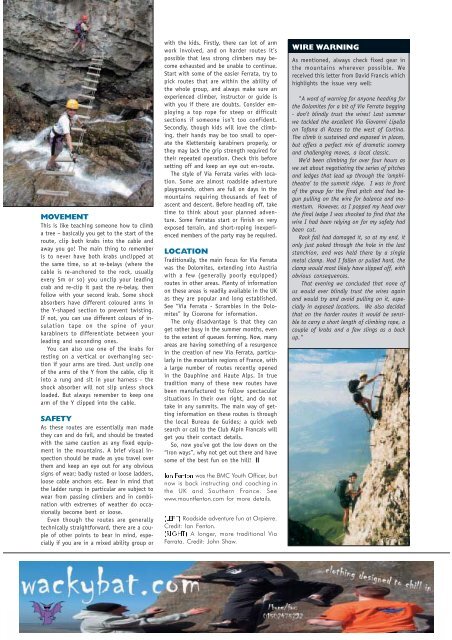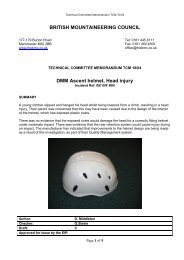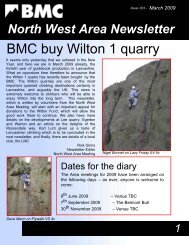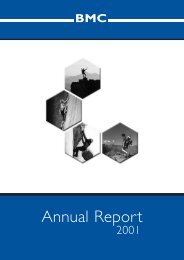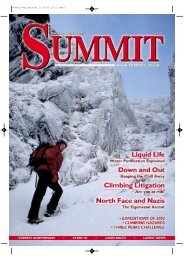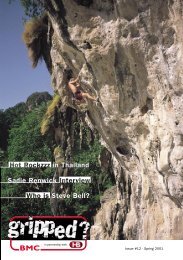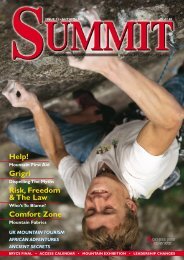Scotland Via Ferrata Expeditions Alpine 4000 Nick Bullock Andy ...
Scotland Via Ferrata Expeditions Alpine 4000 Nick Bullock Andy ...
Scotland Via Ferrata Expeditions Alpine 4000 Nick Bullock Andy ...
Create successful ePaper yourself
Turn your PDF publications into a flip-book with our unique Google optimized e-Paper software.
MOVEMENT<br />
This is like teaching someone how to climb<br />
a tree – basically you get to the start of the<br />
route, clip both krabs into the cable and<br />
away you go! The main thing to remember<br />
is to never have both krabs unclipped at<br />
the same time, so at re-belays (where the<br />
cable is re-anchored to the rock, usually<br />
every 5m or so) you unclip your leading<br />
crab and re-clip it past the re-belay, then<br />
follow with your second krab. Some shock<br />
absorbers have different coloured arms in<br />
the Y-shaped section to prevent twisting.<br />
If not, you can use different colours of insulation<br />
tape on the spine of your<br />
karabiners to differentiate between your<br />
leading and seconding ones.<br />
You can also use one of the krabs for<br />
resting on a vertical or overhanging section<br />
if your arms are tired. Just unclip one<br />
of the arms of the Y from the cable, clip it<br />
into a rung and sit in your harness - the<br />
shock absorber will not slip unless shock<br />
loaded. But always remember to keep one<br />
arm of the Y clipped into the cable.<br />
SAFETY<br />
As these routes are essentially man made<br />
they can and do fail, and should be treated<br />
with the same caution as any fixed equipment<br />
in the mountains. A brief visual inspection<br />
should be made as you travel over<br />
them and keep an eye out for any obvious<br />
signs of wear; badly rusted or loose ladders,<br />
loose cable anchors etc. Bear in mind that<br />
the ladder rungs in particular are subject to<br />
wear from passing climbers and in combination<br />
with extremes of weather do occasionally<br />
become bent or loose.<br />
Even though the routes are generally<br />
technically straightforward, there are a couple<br />
of other points to bear in mind, especially<br />
if you are in a mixed ability group or<br />
with the kids. Firstly, there can lot of arm<br />
work involved, and on harder routes it’s<br />
possible that less strong climbers may become<br />
exhausted and be unable to continue.<br />
Start with some of the easier <strong>Ferrata</strong>, try to<br />
pick routes that are within the ability of<br />
the whole group, and always make sure an<br />
experienced climber, instructor or guide is<br />
with you if there are doubts. Consider employing<br />
a top rope for steep or difficult<br />
sections if someone isn’t too confident.<br />
Secondly, though kids will love the climbing,<br />
their hands may be too small to operate<br />
the Klettersteig karabiners properly, or<br />
they may lack the grip strength required for<br />
their repeated operation. Check this before<br />
setting off and keep an eye out en-route.<br />
The style of <strong>Via</strong> <strong>Ferrata</strong> varies with location.<br />
Some are almost roadside adventure<br />
playgrounds, others are full on days in the<br />
mountains requiring thousands of feet of<br />
ascent and descent. Before heading off, take<br />
time to think about your planned adventure.<br />
Some <strong>Ferrata</strong>s start or finish on very<br />
exposed terrain, and short-roping inexperienced<br />
members of the party may be required.<br />
LOCATION<br />
Traditionally, the main focus for <strong>Via</strong> <strong>Ferrata</strong><br />
was the Dolomites, extending into Austria<br />
with a few (generally poorly equipped)<br />
routes in other areas. Plenty of information<br />
on these areas is readily available in the UK<br />
as they are popular and long established.<br />
See “<strong>Via</strong> <strong>Ferrata</strong> - Scrambles in the Dolomites”<br />
by Cicerone for information.<br />
The only disadvantage is that they can<br />
get rather busy in the summer months, even<br />
to the extent of queues forming. Now, many<br />
areas are having something of a resurgence<br />
in the creation of new <strong>Via</strong> <strong>Ferrata</strong>, particularly<br />
in the mountain regions of France, with<br />
a large number of routes recently opened<br />
in the Dauphine and Haute Alps. In true<br />
tradition many of these new routes have<br />
been manufactured to follow spectacular<br />
situations in their own right, and do not<br />
take in any summits. The main way of getting<br />
information on these routes is through<br />
the local Bureau de Guides; a quick web<br />
search or call to the Club Alpin Francais will<br />
get you their contact details.<br />
So, now you’ve got the low down on the<br />
“iron ways”, why not get out there and have<br />
some of the best fun on the hill! ;<br />
�����������was the BMC Youth Officer, but<br />
now is back instructing and coaching in<br />
the UK and Southern France. See<br />
www.mountfenton.com for more details.<br />
�������Roadside adventure fun at Orpierre.<br />
Credit: Ian Fenton.<br />
������� A longer, more traditional <strong>Via</strong><br />
<strong>Ferrata</strong>. Credit: John Shaw.<br />
WIRE WARNING<br />
As mentioned, always check fixed gear in<br />
the mountains wherever possible. We<br />
received this letter from David Francis which<br />
highlights the issue very well:<br />
"A word of warning for anyone heading for<br />
the Dolomites for a bit of <strong>Via</strong> <strong>Ferrata</strong> bagging<br />
- don’t blindly trust the wires! Last summer<br />
we tackled the excellent <strong>Via</strong> Giovanni Lipella<br />
on Tofana di Rozes to the west of Cortina.<br />
The climb is sustained and exposed in places,<br />
but offers a perfect mix of dramatic scenery<br />
and challenging moves, a local classic.<br />
We’d been climbing for over four hours as<br />
we set about negotiating the series of pitches<br />
and ledges that lead up through the ‘amphitheatre’<br />
to the summit ridge. I was in front<br />
of the group for the final pitch and had begun<br />
pulling on the wire for balance and momentum.<br />
However, as I popped my head over<br />
the final ledge I was shocked to find that the<br />
wire I had been relying on for my safety had<br />
been cut.<br />
Rock fall had damaged it, so at my end, it<br />
only just poked through the hole in the last<br />
stanchion, and was held there by a single<br />
metal clamp. Had I fallen or pulled hard, the<br />
clamp would most likely have slipped off, with<br />
obvious consequences.<br />
That evening we concluded that none of<br />
us would ever blindly trust the wires again<br />
and would try and avoid pulling on it, especially<br />
in exposed locations. We also decided<br />
that on the harder routes it would be sensible<br />
to carry a short length of climbing rope, a<br />
couple of krabs and a few slings as a back<br />
up."<br />
38 30


